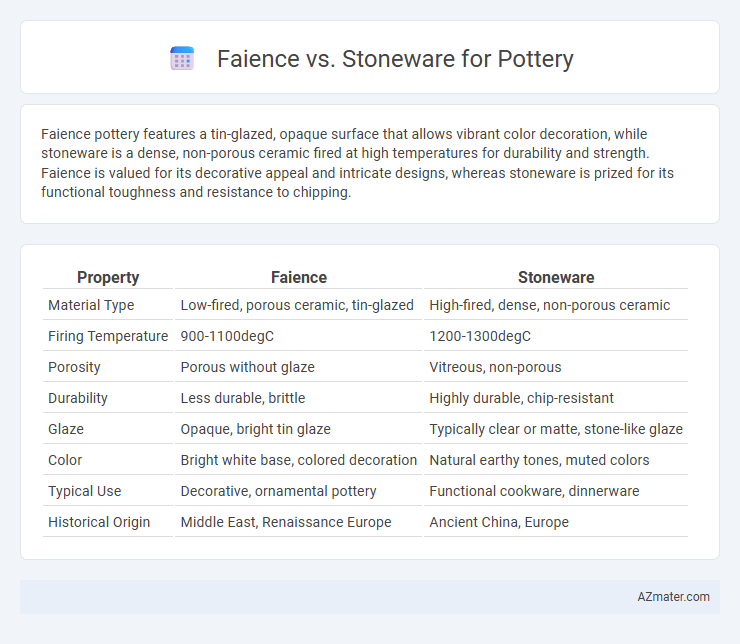Faience pottery features a tin-glazed, opaque surface that allows vibrant color decoration, while stoneware is a dense, non-porous ceramic fired at high temperatures for durability and strength. Faience is valued for its decorative appeal and intricate designs, whereas stoneware is prized for its functional toughness and resistance to chipping.
Table of Comparison
| Property | Faience | Stoneware |
|---|---|---|
| Material Type | Low-fired, porous ceramic, tin-glazed | High-fired, dense, non-porous ceramic |
| Firing Temperature | 900-1100degC | 1200-1300degC |
| Porosity | Porous without glaze | Vitreous, non-porous |
| Durability | Less durable, brittle | Highly durable, chip-resistant |
| Glaze | Opaque, bright tin glaze | Typically clear or matte, stone-like glaze |
| Color | Bright white base, colored decoration | Natural earthy tones, muted colors |
| Typical Use | Decorative, ornamental pottery | Functional cookware, dinnerware |
| Historical Origin | Middle East, Renaissance Europe | Ancient China, Europe |
Introduction to Faience and Stoneware
Faience is a type of glazed ceramic pottery characterized by its bright, opaque tin-glaze that creates a smooth, glossy surface ideal for decorative art. Stoneware is a durable, non-porous ceramic fired at high temperatures, resulting in a dense and strong material suited for functional tableware and cookware. Both faience and stoneware have distinct composition and firing processes that influence their texture, strength, and visual appeal.
Defining Faience: Origins and Characteristics
Faience pottery originates from ancient Egypt and Mesopotamia, characterized by its brightly colored, glazed surface made using a silica-based composition often combined with alkaline salts and copper-based pigments. This earthenware is renowned for its glossy finish and vibrant blue-green hues, achieved through a low-temperature firing process that creates a glassy coating over the porous body. Unlike stoneware, which is dense, non-porous, and fired at high temperatures, faience remains slightly porous and fragile, making it more decorative than utilitarian.
Understanding Stoneware: Composition and Features
Stoneware is a durable, non-porous ceramic made from dense clay fired at high temperatures between 1,200degC and 1,300degC, resulting in a vitrified, glass-like surface. Its composition typically includes kaolin, ball clay, and feldspar, which contribute to its strength, chip resistance, and water-tight properties without requiring a glaze. This makes stoneware ideal for functional pottery like dinnerware and cookware, offering superior durability compared to faience, which is porous and glazed earthenware typically fired at lower temperatures.
Historical Context: Faience vs Stoneware
Faience pottery, originating in ancient Egypt and popularized across the Mediterranean during the Bronze Age, is characterized by its tin-glazed earthenware with a bright, opaque surface often decorated with intricate patterns and vibrant colors. Stoneware, developed later in East Asia around the Shang Dynasty and becoming prominent in Europe by the medieval period, is a durable, vitrified ceramic fired at high temperatures resulting in non-porous, dense material suitable for utilitarian and artistic use. The historical context reveals that faience was primarily valued for decorative and ceremonial purposes, whereas stoneware's robustness made it essential for everyday domestic and commercial applications.
Material Preparation and Production Differences
Faience pottery involves a tin-glazed earthenware body with a porous, relatively soft ceramic made from refined clays mixed with quartz and chalk, requiring careful glazing to achieve its characteristic opaque, glossy surface. Stoneware is produced from denser, feldspar-rich clays fired at higher temperatures (typically 1200-1300degC), resulting in a vitrified, non-porous body that is more durable and less prone to chipping. The production process for faience demands precise glaze formulation and lower firing temperatures to preserve the glaze's opacity, while stoneware's firing process prioritizes clay maturation and strength without needing an opaque glaze.
Firing Temperatures and Techniques
Faience pottery typically undergoes a lower firing temperature range of around 800-1000degC compared to stoneware, which is fired at higher temperatures between 1200-1300degC. The lower firing temperature of faience allows for the application of vibrant, glossy glazes achieved through tin or lead-based glazes, while stoneware requires high-temperature-resistant materials that vitrify, resulting in dense, durable, and non-porous ceramics. Techniques for firing stoneware often involve kiln atmospheres such as oxidation or reduction to influence surface texture and color, whereas faience benefits from controlled, lower-temperature firings to preserve its delicate glaze and intricate designs.
Durability and Functional Performance
Faience pottery, known for its glazed surface and decorative appeal, is less durable and more prone to chipping compared to stoneware, which is fired at higher temperatures, resulting in a denser, more robust material. Stoneware's vitrified composition offers superior resistance to moisture, thermal shock, and everyday wear, making it ideal for functional items like dishes and cookware. The hardness and non-porous nature of stoneware ensure long-lasting performance in both domestic and commercial pottery applications.
Aesthetic Qualities: Colors, Glazes, and Textures
Faience pottery is renowned for its vibrant, opaque glazes that create a smooth, glossy surface often in bright blues, greens, and yellows, ideal for intricate decorative patterns. Stoneware offers a more rustic aesthetic with earth-toned hues and matte or satin finishes, showcasing natural textures and variations from high-temperature firing. The contrast between faience's delicate, colorful sheen and stoneware's robust, tactile appeal highlights their distinct visual and tactile qualities in ceramic art.
Common Uses in Pottery and Ceramic Arts
Faience is commonly used for decorative pottery and fine ceramics due to its glazed surface that allows vibrant color applications, making it ideal for ornamental tiles, figurines, and tableware. Stoneware, known for its durability and non-porous nature after firing, is widely favored for functional pottery such as dinnerware, cookware, and storage jars that require strength and resistance to wear. Both materials play essential roles in ceramic arts, with faience emphasizing aesthetic appeal and stoneware prioritizing practical use.
Choosing Between Faience and Stoneware for Your Project
Choosing between faience and stoneware for pottery depends on your project's functional and aesthetic needs. Faience, a tin-glazed earthenware, offers vibrant, opaque colors ideal for decorative pieces but is more porous and less durable than stoneware. Stoneware, known for its strength and vitrification at high temperatures, suits utilitarian pottery requiring durability and resistance to chipping and cracking.

Infographic: Faience vs Stoneware for Pottery
 azmater.com
azmater.com